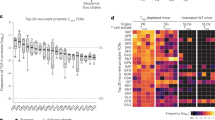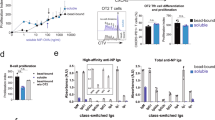Abstract
The apparent high frequency of alloreactive T cells has suggested that the two subpopulations—T cells specific for soluble protein antigens and alloreactive T cells—must overlap1–3. However, the existence of a set of germ-line genes encoding a family of anti-MHC (major histocompatibility complex) antigen-specific T-cell receptors has also been postulated to explain the high frequency of alloreactive clones4–7. In these latter models the two T-cell subpopulations are viewed as separate. Studies on whole T-cell populations have examined these two points of view by looking for cross-stimulation of alloreactive cells with antigen and vice versa8–11. Although significant cross-reactions have been reported, the problem of nonspecific recruitment made interpretation of results difficult. Recent developments in the cloning of antigen-specific T lymphocytes12–18 have finally allowed investigation at the single-cell level where the results should be unambiguous, von Boehmer et al.14 have isolated a cytotoxic clone specific for the H–Y antigen in conjunction with the syngeneic MHC antigens coded for by Db. This clone was also cytotoxic for spleen cells bearing the alloantigens coded for by Dd in the absence of the H–Y antigen. However, because cytotoxic clones only grow in the presence of T-cell growth factor (TCGF) and because von Boehmer et al. were unable to stimulate or enrich for Dd-specific cytotoxic activity from bulk cultures initially stimulated with H–Y and Db-bearing spleen cells14, they hesitate to conclude that the same cell can respond to both foreign and alloantigens. We show here that a (dinitrophenyl-ovalbumin)(DNP-OVA)-specific T-cell clone from a B10.A mouse can be stimulated to divide (and propagate) in vitro with B10.S allogeneic spleen cells in the absence of DNP-OVA and B10.A antigen-presenting cells. Extensive recloning strongly suggests that a single T-cell clone is responding to two separate stimuli, a specific alloantigen and a soluble antigen in conjunction with self-MHC products.
This is a preview of subscription content, access via your institution
Access options
Subscribe to this journal
Receive 51 print issues and online access
$199.00 per year
only $3.90 per issue
Buy this article
- Purchase on Springer Link
- Instant access to full article PDF
Prices may be subject to local taxes which are calculated during checkout
Similar content being viewed by others
References
Simonsen, M. Cold Spring Harb. Symp. quant. Biol. 32, 517–523 (1967).
Wilson, D. B. in Progress in Immunology Vol. 2 (eds Brent, L. & Holborow, J.) 145–156 (Elsevier, Amsterdam, 1974).
Janeway, C. A. Jr, Wigzell, H. & Binz, H. Scand. J. Immun. 5, 993–1001 (1976).
Jerne, N. K. Eur. J. Immun. 1, 1–9 (1971).
Blanden, R. V. & Ada, G. L. Scand. J. Immun. 7, 181–190 (1978).
Langman, R. E. Rev. physiol. biochem. Pharmac. 81, 1–37 (1978).
Cohn, M. & Epstein, R. Cell. Immun. 39, 125–153 (1978).
Burakoff, S. J. et al. J. exp. Med. 148, 1414–1422 (1978).
Lemonnier, F., Burakoff, S. J., Germain, R. N. & Benacerraf, B. Proc. natn. Acad. Sci. U.S.A. 74, 1229–1233 (1977).
Bevan, M. J. Proc. natn. Acad. Sci. U.S.A. 74, 2094–2098 (1977).
Heber-Katz, E. & Wilson, D. B. J. exp. Med. 143, 701–706 (1976).
Sredni, B., Tse, H. Y. & Schwartz, R. H. Nature 283, 581–583 (1980).
Schreier, M. H. & Tees, R. Int. Archs Allergy appl. Immun. 61, 227–237 (1980).
von Boehmer, H. et al. Eur. J. Immun. 9, 592–597 (1979).
Watson, J. J. exp. Med. 150, 1510–1519 (1979).
Baker, P. E., Gillis, S., Ferm, M. M. & Smith, K. A. J. Immun. 121, 2168–2173 (1978).
Rosenberg, S. A., Spiess, P. J. & Schwarz, S. J. Immun. 121, 1946–1955 (1978).
Schawaller, R., Röllinghoff, M. & Wagner, H. Scand. J. Immun. 11, 449–453 (1980).
Schreffler, D. C. & David, C. S. Adv. Immun. 20, 125 (1975).
von Boehmer, H., Haas, W. & Jerne, N. K. Proc. natn. Acad. Sci. U.S.A. 75, 2439–2442 (1978).
Author information
Authors and Affiliations
Rights and permissions
About this article
Cite this article
Sredni, B., Schwartz, R. Alloreactivity of an antigen-specific T-cell clone. Nature 287, 855–857 (1980). https://doi.org/10.1038/287855a0
Received:
Accepted:
Issue Date:
DOI: https://doi.org/10.1038/287855a0
This article is cited by
-
Potential MHC diversity in T cell selection in the thymus
Immunology & Cell Biology (1995)
-
Recognition of multiple class II signals by murine T cell antigen receptors
Immunologic Research (1988)
-
Fine specificity and T-cell receptor ?-chain gene rearrangements of five H-2Db-specific cytotoxic T-cell clones
Immunogenetics (1987)
-
Distribution of alloreactivity among antigen-specific, class II-restricted T-cell clones and hybridomas
Immunogenetics (1985)
-
Rearrangements of T-cell receptor gene YT35 in human DNA from thymic leukaemia T-cell lines and functional T-cell clones
Nature (1984)
Comments
By submitting a comment you agree to abide by our Terms and Community Guidelines. If you find something abusive or that does not comply with our terms or guidelines please flag it as inappropriate.



